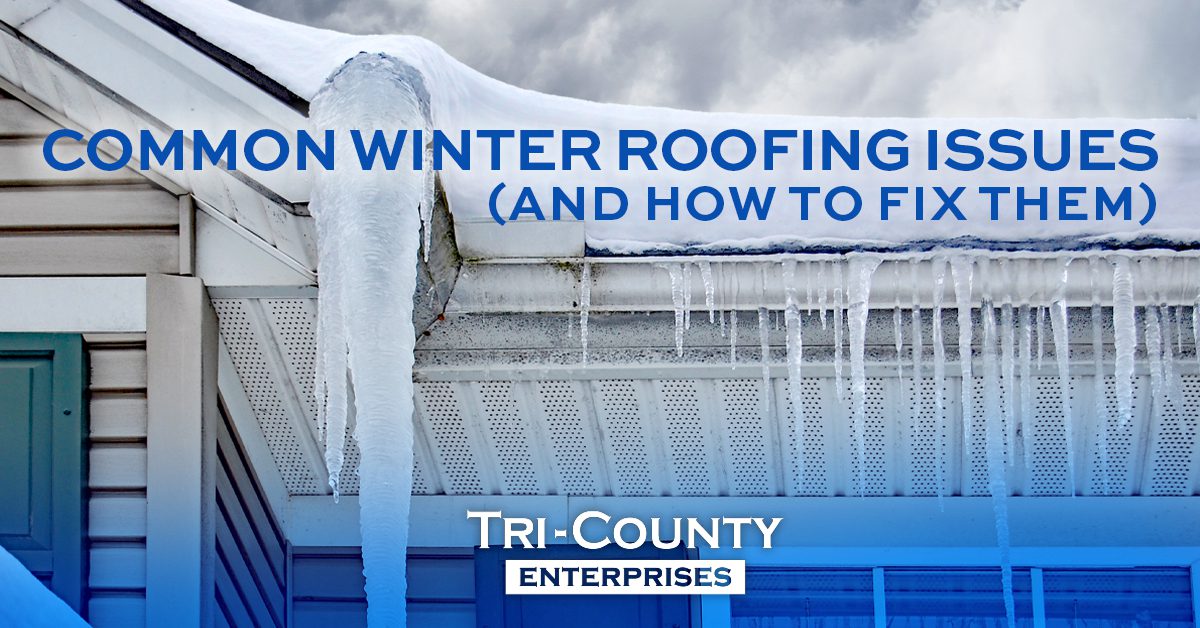
Nothing works harder than your roof. It keeps everything inside your home safe and dry. It protects you from Iowa’s harsh winter weather. And it’s your first line of defense against critters like bats and raccoons.
Although you may think of your roof as just one part of your home, it’s actually made up of more than a dozen different components—from the rafters that give it shape to the shingles and flashing that keep it water-tight. And when one of those components is stressed or damaged, it can throw the whole roofing system into disarray.
Especially in the winter.
The 3 Most Common Winter Roofing Issues
1) Icicles
They may look cool (pun intended), but icicles pose a real threat to your safety. And if you let your dog outside to do its business, you definitely want to make sure they’re not dangling anywhere near their favorite spot!
The short-term fix: Knock them down.
First, make sure any pets and kids are inside the house. Next, with the end of a rake or another long tool, carefully knock the icicles off your roof, one by one. Make sure you’re not standing directly underneath them and put as much room as possible between you and the falling icicles. If the icicles are big and too far out of your reach, don’t put yourself in danger. When in doubt, call the professionals.
The long-term solution: Install gutter guards.
Leaves and maple seeds can quickly clog your gutters, making it difficult for water to flow through. When temperatures freeze (and then unfreeze and freeze again), icicles form as the water drips from your gutters.
You can help prevent icicles by cleaning out your gutters regularly (once or twice a year). But if you’re not a huge fan of the chore, you can install gutter guards that keep debris out, reducing the frequency of cleanings.
We’re big fans of mesh gutter guards from Leaf Solutions, which keep even small debris like pine needles out.
2) Ice Dams
Ice dams are like icicles on steroids—big chunks of ice that pool near the edges of your roof and gutters. These typically occur when the steep part of your roof is warmer than the bottom, causing snow to melt and then freeze again before it can drain through your gutters. (Read our blog about ice dams to learn more.)
Ice dams can grow big and heavy fast, causing your gutters to detach from your roof and fall to the ground. But the biggest threat they pose is sending water under your shingles and into the walls of your home—an expensive problem you don’t want to deal with, especially during the holidays.
The short-term fix: Insulate your attic.
Poor insulation is one of the major causes of ice dams. Adding high-quality insulation to your attic floor can help keep your heat in the main levels of your home, making your attic cooler and the temperature of your roof more even. However, if your roof isn’t properly sealed, you’ll likely encounter this issue again.
The long-term solution: Repair or replace your soffits.
If your soffits are damaged, your attic won’t ventilate properly and it will be difficult to keep it at a steady temperature. The solution is to either repair or replace them. Thankfully, quality, durable soffits installed by a professional crew should last you 15-20 years, so you’re unlikely to have to make this repair more than once.
3) Loose or Damaged Flashing
Your roof’s flashing is made up of sheets of metal installed near vulnerable areas of your roof like chimneys, skylights and vents. Its job is to create a strong seal that keeps water out and prevents the dreaded leaky roof.
Since flashing is made from metal — a material that expands and contracts — it’s not impervious to winter wear and tear. Big overnight changes to temperature can cause it to wrinkle. It can rust. And windstorms can strip pieces of flashing clear off your roof. When that happens, melting snow suddenly has a secret tunnel leading directly into your home.
The short-term fix: Repair and replace the flashing.
Flashing repairs can be relatively quick and simple, provided other parts of your roof aren’t also damaged. But we’re not suggesting you bust out the tools and attempt to make DIY repairs. There’s a good reason you don’t want to climb on your roof in the middle of winter — snow and ice. Professionals have the experience (and the right equipment) to make repairs safely and efficiently.
If your roofer finds that your flashing is significantly damaged or beyond repair, the only option is to replace it. Thankfully, it’s often much less expensive to replace your flashing than having to repair interior water damage and buy new furniture.
The long-term solution: Have your roof inspected after storms.
One of the biggest reasons flashing fails is due to storm damage. After a big hail or windstorm, it’s important to have a professional inspect your roof up close for signs of damage. Often, if the damage is minor, they can make repairs on the spot. In a worst-case scenario where you need to replace not only the flashing but your entire roof, make sure you’re working with an experienced, reputable contractor with an excellent score from the Better Business Bureau (BBB).
Emergencies happen. That’s why Tri-County is available for roofing repairs — and even replacements — all winter long. In many cases, we can complete your entire project in a single day provided there is no inclement weather to delay the process. In other cases, we can make repairs and then get you scheduled for a full replacement when the time is right.
Don’t wait until spring to address critical damage to your roof. Give Tri-County a call and feel good about crossing one more thing off your home maintenance to-do list.